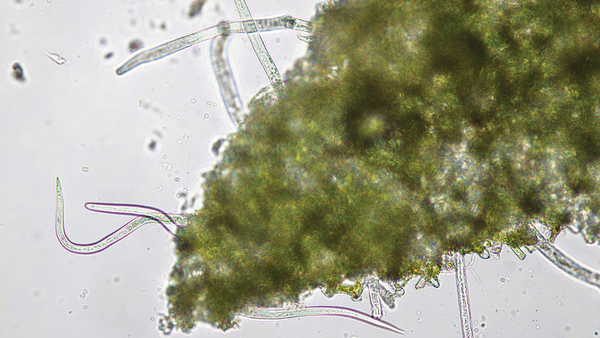
Oak wilt kills hundreds of thousands of oaks (Quercus spp. and cvs. Zones 3–11) in the Midwest and beyond every year, but what is it? Oak wilt is caused by a fungus (Bretziella fagacearum, formerly Ceratocystis fagacearum) This lethal fungal disease is a threat to oaks in residential settings and forests. Oak wilt fungus grows through the infected oak’s water conducting system (xylem) and clogs the vascular system, leading to noticeable symptoms and in many cases, immediate decline and death. Thus far, oak wilt has been identified in more than 20 U.S. states, and for the first time in Ontario in May 2023.

What types of oak trees does oak wilt affect?
This disease is fatal for the red oak group, which includes the following common Midwest species that feature pointed leaf lobes:
- Scarlet oak (Q. coccinea, Zones 4–9)
- Pin oak (Q. palustris, Zones 4–8)
- Northern red oak (Q. rubra, Zones 4–8)
- Black oak (Q. velutina, Zones 3–9)
Oak wilt can kill a member of the red oak group within one to two months. Trees in the white oak group, which have rounded leaf lobes, experience slower disease progression and rarely are killed in one season. They may ultimately survive the infection. The white oak group includes these common Midwest species:
- White oak (Q. alba, Zones 3–9)
- Swamp white oak (Q. bicolor, Zones 3–8)
- Bur oak (Q. macrocarpa, Zones 3–8)
- Post oak (Q. stellata, Zones 5–9)
Research has shown that bur oaks are considered intermediate in susceptibility.
What do symptoms look like?
Symptoms of the disease, typically observed between June and September, include single branches wilting and dying quickly. Leaves on affected branches often turn bronze, tan, or dull green, with the symptoms starting in the tips and outer margins of the leaves. Leaves may also droop, curl, or fall from the tree, even when still green. These symptoms are most common in the months of July and August. The progression and spread of symptoms is rampant, with very evident and conspicuous decline.
How does oak wilt spread?

The spread of this disease from infected to healthy trees happens in one of two ways. Naturally grafted root systems are not uncommon for adjacent oaks that commonly share a collective system, which allows for the quick movement of the disease from tree to tree. This is the most common way for the disease to spread between nearby oak trees. In addition, certain sap-feeding beetles can become a vector and carry spores from infected trees to new host trees. The beetles are attracted to the “fruity” smelling fungal mats in infected trees and pick up spores that are then transported to other trees. Healthy oaks that have been pruned or wounded during the growing season become enticing targets for these beetles, which can also carry spores from infected logs and firewood. Trees that have died of oak wilt can harbor spores for one year aboveground and two years in the root system.
What can I do to stop the spread of the fungus?

In cases of oaks dying and showing collective decline, one method of controlling the continued spread through the root grafts is to mechanically trench and sever the root systems to a depth of 5 feet beneath grade. This approach has been common in forests when groupings of trees show evidence of oak wilt infection. Dead or dying trees should be removed, and the infected wood should not be transported off site. Burying or burning the wood is acceptable, and any equipment used to cut or handle infected wood should be disinfected and sanitized before moving out of the area.
As a general rule of thumb, oaks should only be pruned during the dormant season as fresh cuts (or wounds) during the growing season in the Midwest (April to October) become magnets for sap-feeding beetles that may transfer the infection. Any necessary cuts or wounds that occur at this time should be immediately covered with wound paint products to avoid attracting beetles. There is also some promising research evaluating the potential for proactive fungicide injections to healthy trees in areas where oak wilt is of concern. Becoming aware of the symptoms of this disease along with understanding the aggressive mitigation and control efforts is paramount in helping slow the spread of oak wilt. There are many other sources for additional information on oak wilt. Check with your state cooperative extension service office for more information and assistance with confirming a possible oak wilt infection.
More tree diseases to know about:
Learn to Control This Common Conifer Tree Disease
What You Need to Know About Beech Leaf Disease
—Mark Dwyer is the garden manager for the Edgerton Hospital Healing Garden in Edgerton, Wisconsin, and he operates Landscape Prescriptions by MD.
Fine Gardening Recommended Products

Corona High Performance Orchard Loppers
Fine Gardening receives a commission for items purchased through links on this site, including Amazon Associates and other affiliate advertising programs.

Pruning Simplified: A Step-by-Step Guide to 50 Popular Trees and Shrubs
Fine Gardening receives a commission for items purchased through links on this site, including Amazon Associates and other affiliate advertising programs.

ARS Telescoping Long Reach Pruner
Fine Gardening receives a commission for items purchased through links on this site, including Amazon Associates and other affiliate advertising programs.



















Comments
Log in or create an account to post a comment.
Sign up Log in